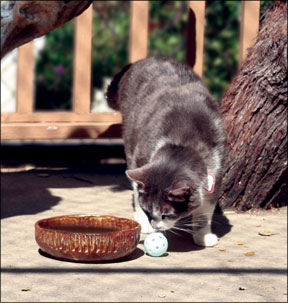If your cat has ever scratched the floor before or after eating a meal, attempted to cover uneaten food, or (yuck!) plopped a toy into her food or water dish, please raise your hand. Right now, many of you are probably waving your hand in the air and nodding your head knowingly. If suppertime at your house has more the 288 ambience of a junior high school cafeteria than a chic caf, read on. Our Cornell experts help make sense of some of our cats quirkiest food-related behaviors. Eating Etiquette Scratching around their bowls or trying to cover food is a common, albeit puzzling behavior seen in many cats. Just why our fastidious felines do this remains a mystery, but several theories have been suggested. “We can only speculate, but most behaviorists think that cats scratch around their food for either hygienic reasons or for storing leftovers,” says Julia Albright, MA, DVM, an animal behavior resident at Cornell Universitys College of Veterinary Medicine. “So, as strange as it may look, cats probably scratch around their food and water bowls because they dont like their food or because theyve had enough for now and think they are storing it for later.” What about cats that have a habit of dropping their toys into their food or water dish? Many owners are hungry for answers, but again, experts can only offer a hypothesis. “It may have something to do with the fact that toys are really just surrogate prey to a cat,” says James Richards, DVM, director of the Cornell Feline Health Center. “Because cats often eat their prey, they put the toys in the food dish because thats where food goes.” Other reasons for this behavior may include a cats desire to put their toys away in a “safe” place (they consider their food area to be secure) and save them for another play session. This behavior is similar to cats in the wild who often take their prey back to their nest to hide it from potential predators or to show their kittens how to hunt. Another possible explanation suggests that cats are manifesting a “gathering/collecting” behavior. Just as feral mothers will return wandering kittens to the nest or move them from one place to another by the nape of the neck, domestic cats will transport a toy to their feeding area. If your cat continues scratching or attempting to cover his food, try gradually introducing a different brand or type of food. If hes currently eating wet food, try dry food. If he leaves part of his meal untouched, serve a smaller portion next time. Chew on This Dogs may be chastised for chewing on our favorite Jimmy Choo shoes, but cats also have an appetite for expensive (and dangerous) items: fabrics, electrical cords and even pins and needles can be considered enticing “snacks.” Some speculate that chewing or sucking on fabric – wool seems to be a favorite – is a comfort-seeking behavior. Dr. Albright suggests that the behavior arises because a cats food is deficient in certain nutrients. “I tell owners to add high-fiber foods to their cats diet,” she says. “In addition, I suggest providing alternatives for chewing such as chicken bones (cooked only, to kill potentially harmful bacteria, and also because raw bones can splinter) and 100-percent pure wool objects. Pure wool will not cause a blockage.” Dr. Albright is quick to note that a fiber deficiency is but one possible reason for compulsive chewing. Genetics (Oriental breeds such as the Siamese and Burmese are most prone to this obsessive-compulsive disorder), lack of environmental enrichment, a systemic or neurological disease or stress may also be to blame. “Stress is a big factor,” notes Dr. Albright. “Talk to your veterinarian or a veterinary behaviorist about ways to reduce stress specific to your household.” Although many kittens will outgrow their desire to suckle and chew on sweaters, socks and blankets, others will exhibit this behavior their entire lives. Keep in mind that chewing (and swallowing) yarn, string or wool can be dangerous – even life-threatening – to your cat. Take steps to keep chewable objects out of your cats reach, cover electrical cords with chew-resistant plastic covering (available at most hardware and home improvement stores), and, perhaps most importantly, spend more time playing with your cat. This increased interaction will help distract him from destructive behavior and provide a positive outlet for his pent-up energy. If these treatments prove unsuccessful, try spraying the object of desire with a commercial pet repellent. Repellents are safe for fabrics but emit an unpleasant odor or taste to the cat. In severe cases, your veterinarian may prescribe an anti-anxiety medication to help control your cats urge to chew on clothing or other items. So, the next time you hear the familiar “suppertime scratch” or find that your cat is unraveling your favorite knit sweater faster than your nerves, take heart. With a little patience and planning on your part, you can find a happy balance where both your felines and your fabrics will be safe. 



